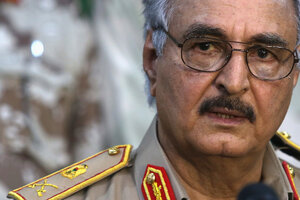Why is Libya falling apart?
Western powers are concerned that the fractured nation in North Africa is fertile ground for Islamic State militants.

Gen. Khalifa Haftar is commanding the Libyan National Army in eastern Libya, just one of the warring factions that is battling for control of the country.
Esam Omran Al-Fetori/Reuters/file
Since Muammar Qaddafi’s death in 2011, gangster-style militias in Libya have proliferated and are fighting over oil as two rival governments compete for control. Now the self-described Islamic State has arrived to try to put down roots and recruit militants. How did the country get to this point, and are there any signs of stability or even peace?
What events led to today’s turmoil in Libya?
The war to oust former dictator Qaddafi – backed by the United States, NATO war planes, and neighboring countries such as Qatar– planted the seeds for Libya’s turmoil today. (This sentence was edited after posting to correct Qaddafi's position after seizing power.)
Although the celebrations were raucous in Tripoli’s Martyrs Square, the effort to overthrow Qaddafi – which led to his death – had relied on locally and regionally based militias that were never under any kind of central command. In the aftermath, the groups quickly fell to fighting over Libya’s rich oil reserves.
Along with the gangster-style militias, such as those from Misurata and Zintan that frequently fight for control of oil terminals and the airport in Tripoli, came the revitalization of militant Islamists, who had been largely crushed under Qaddafi following years of brutal tactics that targeted both fighters and their families. Across the country, tribal rivalries are overlaid on regional ones with competing ideas about the role of religion in the state.
Adding to the challenges is the fallout from Qaddafi’s efforts to destroy anything that could challenge his dominance – from the military he controlled down to the lowest levels of civil service.
Have there been any signs of progress?
Not many. An election in 2012 brought to power an Islamist-leaning national assembly, which was expected to write a new constitution. That work never really got off the ground as the country teetered on the edge of civil war.
In June 2014, new elections were held – this time bringing a less-Islamist parliament into power. At the time, many world powers and many Libyans breathed a sigh of relief.
But by August of last year, an Islamist militia called Libya Dawn, built on a core of militia fighters from Misurata, a city that had survived a prolonged siege and some of the ugliest fighting of the war, seized Tripoli. Libya Dawn also draws support from the Berber minority, the Muslim Brotherhood, and Al Qaeda veterans. The elected parliament fled to Tobruk, where it sits to this day.
Then in November, Libya’s Supreme Court nullified the June elections – something few world powers recognize – and the country has been in a state of limbo ever since.
Who is fighting the Islamist militants in Libya?
The so-called Libyan National Army is under the command of Gen. Khalifa Haftar, who has a checkered past. As a former aide to Qaddafi and a supporter of the coup that brought him to power, he recently spent 20 years in exile in Virginia, arranged by the CIA after he backed a failed coup against Qaddafi that was mounted from Chad. He returned to Libya during the uprising in 2011.
Haftar had attempted another coup of his own against the first elected national assembly, but now he fights what he says is a “war on terror” for his allies in Tobruk, from a base of his own in the Green Mountains. His forces are strongest in the nation’s east. Libya Dawn is in the west. But these two rivals are not alone.
Where’s IS in all of this?
Its presence is increasingly apparent. Islamist hard-liners have been carrying out an assassination campaign against more secular-leaning rivals off and on since 2011, particularly in Benghazi, the heart of the 2011 uprising. Benghazi is also where US Ambassador Chris Stevens and three other Americans were murdered by Islamist militias on Sept. 11, 2012.
IS, the millenarian jihadi movement that has seized territory in Syria and Iraq, now appears to be developing a force of its own in Libya. It has carried out a series of car bombings, assassinations, and other attacks, and most notoriously beheaded 21 Christian laborers from Egypt in February in a lavishly produced video. The group has openly paraded thousands of fighters in both the cities of Sirte and Derna, the traditional heart of Islamist militancy in Libya.
It is looking to expand its influence, and its uneasy alliance with Libya Dawn may not last long. In late January, fighters proclaiming loyalty to IS stormed Tripoli’s Corinthia Hotel, killing five foreigners – one an American – and five Libyans.
What is likely to happen next?
The United Nations has been trying and failing to get a national dialogue going amid the chaos. Following the murder of the Egyptians by IS, Egypt launched airstrikes around Derna, which saw the group retaliate against supporters of Haftar with car bombs in the town of Qubbah, killing 45.
But the chances for productive talks in the near term look grim. The government in the east rejected talks after the car bomb attack. And on Feb. 23, the local IS affiliate, which is sometimes called the Battar Brigade, was reported by Libyan media to have declared war on pretty much everyone else – not only Haftar and the parliament in Tobruk, but also on the government installed and backed by Libya Dawn in Tripoli.

